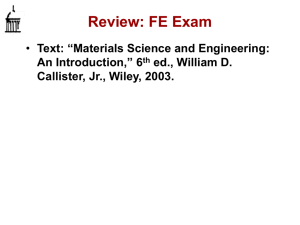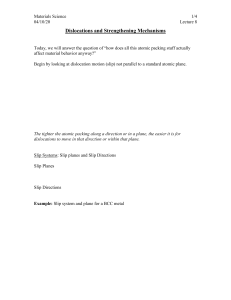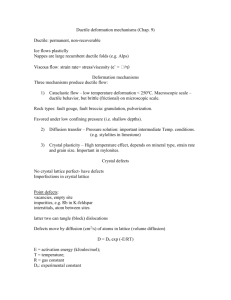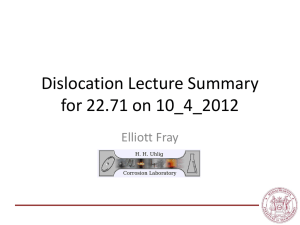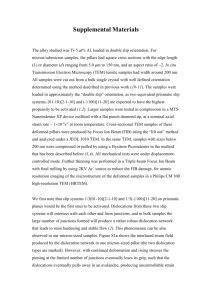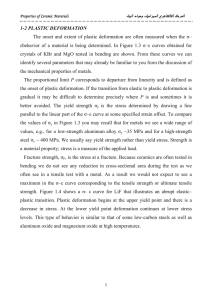1.2 PLASTIC DEFORMATION
advertisement
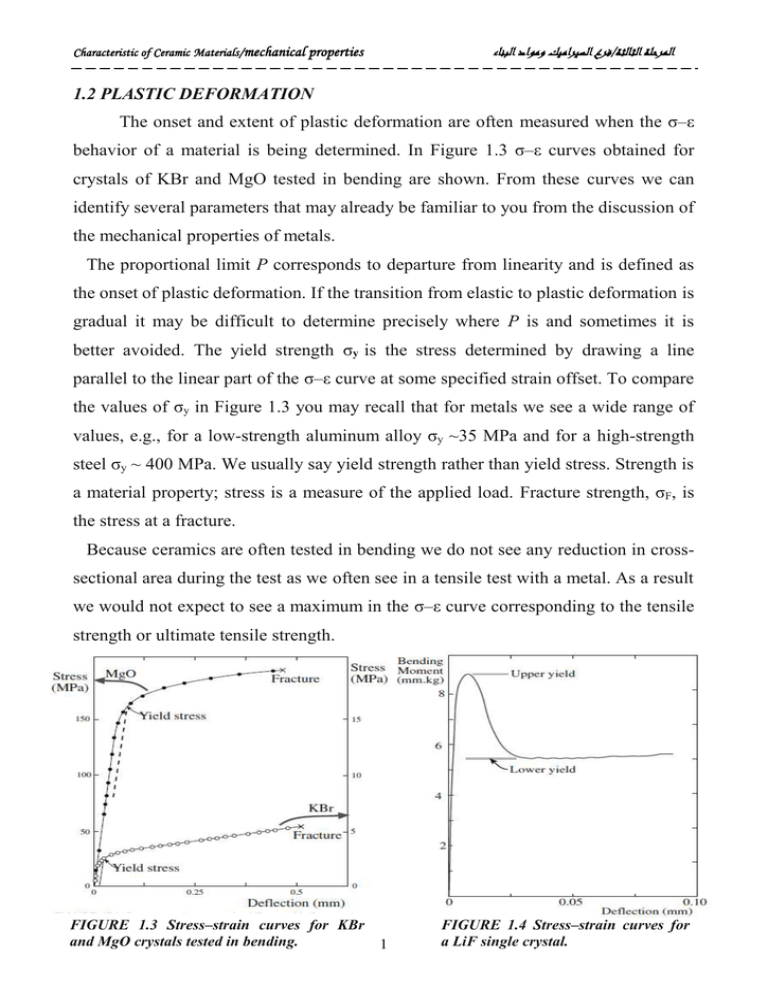
فرع السيراميك ومواد البناء/المرحلة الثالثة
Characteristic of Ceramic Materials/mechanical properties
1.2 PLASTIC DEFORMATION
The onset and extent of plastic deformation are often measured when the σ–ε
behavior of a material is being determined. In Figure 1.3 σ–ε curves obtained for
crystals of KBr and MgO tested in bending are shown. From these curves we can
identify several parameters that may already be familiar to you from the discussion of
the mechanical properties of metals.
The proportional limit P corresponds to departure from linearity and is defined as
the onset of plastic deformation. If the transition from elastic to plastic deformation is
gradual it may be difficult to determine precisely where P is and sometimes it is
better avoided. The yield strength σy is the stress determined by drawing a line
parallel to the linear part of the σ–ε curve at some specified strain offset. To compare
the values of σy in Figure 1.3 you may recall that for metals we see a wide range of
values, e.g., for a low-strength aluminum alloy σy ~35 MPa and for a high-strength
steel σy ~ 400 MPa. We usually say yield strength rather than yield stress. Strength is
a material property; stress is a measure of the applied load. Fracture strength, σF, is
the stress at a fracture.
Because ceramics are often tested in bending we do not see any reduction in crosssectional area during the test as we often see in a tensile test with a metal. As a result
we would not expect to see a maximum in the σ–ε curve corresponding to the tensile
strength or ultimate tensile strength.
FIGURE 1.3 Stress–strain curves for KBr
and MgO crystals tested in bending.
1
FIGURE 1.4 Stress–strain curves for
a LiF single crystal.
فرع السيراميك ومواد البناء/المرحلة الثالثة
Characteristic of Ceramic Materials/mechanical properties
Figure 1.4 shows a σ- ε curve for LiF that illustrates an abrupt elastic–plastic
transition. Plastic deformation begins at the upper yield point and there is a decrease
in stress. At the lower yield point deformation continues at lower stress levels. This
type of behavior is similar to that of some low-carbon steels as well as aluminum
oxide and magnesium oxide at high temperatures.
1.2-1 Dislocations
Dislocations are line defects, but like all crystal defects, they are actually
volume defects; i.e., we should think of them as tubes, or pipes, whose properties
change across the tube radius and that generally do not have cylindrical symmetry.
Two vectors define the fundamental properties of any dislocation:
- The line direction
- The Burgers vector
The glide plane of the dislocation is the plane that contains both vectors. They are
almost always present in crystals because of how the crystal grew or because it was
deformed. Therefore dislocations usually form due to non equilibrium conditions,
such as thermal and mechanical processing, or for thin films and single crystals,
during growth. There are two special types of dislocation.
- Edge dislocations
- Screw dislocations
All other dislocations are referred to as “mixed.”
*Defining the Burgers Vector and the Glide Plane
The Burgers vector is defined by constructing a closed circuit around the
dislocation line. We first draw a circuit around the dislocation in a clockwise (righthanded screw) direction from the start (S) to the finish (F) as shown in Figure 1.5a.
We then transfer this circuit to a perfect crystal as shown in Figure 1.5b. If there is a
dislocation, this second loop will not close on itself. We then define the vector FS,
which is required to close the loop in the perfect crystal, as the Burgers vector. This
method of defining the Burgers vector, b, is known as the FS/RH perfect-crystal
convention. Some other texts, and even some of the classic papers, use a convention
2
فرع السيراميك ومواد البناء/المرحلة الثالثة
Characteristic of Ceramic Materials/mechanical properties
that produces the opposite sign for the Burgers vector. For example, they might use
an anticlockwise circuit, set b = SF, or draw the circuit in the perfect crystal first.
You must use a convention consistently.
- Edge dislocation: An extra half-plane of atoms is inserted above the glide plane as
illustrated in Figure 1.5a. The Burgers vector is perpendicular to the dislocation line,
u. The Burgers vector will be opposite if the extra half plane is below the glide plane.
- Screw dislocation: Successive atomic planes are connected to form the surface of a
helix (or screw) around the dislocation line where the dislocation is perpendicular to
the planes: like the core of a spiral, parking ramp. The Burgers vector is parallel to
the dislocation line and can point up or down for a left- or right-handed screw.
- Glide plane: This is the plane containing both the dislocation line and the Burgers
vector.
FIGURE 1.5 the Burgers circuit in the imperfect and perfect lattices for an edge dislocation in a
simple-cubic crystal.
1.2-2 Dislocation in Ceramics:
The structure of the dislocation core in ceramics depends on three factors
1. Charge of the ions
2. Size of ions
3. Presence of directional bonds.
Perhaps the more important question is: why learn about dislocations in ceramics
when ceramics do not deform plastically as easily as metals?
3
فرع السيراميك ومواد البناء/المرحلة الثالثة
Characteristic of Ceramic Materials/mechanical properties
* Structure of the Core:
Not much is really known about the core of dislocations in ceramics. For
understand that chosen one Burgers vector (usually the most important one), one line
direction, and thus one glide plane. Furthermore, we usually draw the edge
dislocation because it is easiest to draw, not because it is the most important. In this
section, we will assume that the dislocation core is compact. The examples are
chosen to illustrate particular features.
- NaCl: it is relatively simple and illustrates the effect of charge.
- Si: it illustrates the effect of directional (covalent) bonding.
- Al2O3 and olivine: they are non cubic materials.
Although NaCl and MgO structures are both based on the cubic-F lattice, like Cu,
there is no evidence for any dislocation dissociation. A schematic diagram of such a
dislocation viewed along the [001] direction is shown in Figure 1.6. All the ions seen
here lie in the same (001) plane. If we remove this plane of atoms the structure looks
the same, but all the ions are reversed in sign. So charge is balanced as long as there
are no jogs or kinks on the dislocation.
The glide plane for dislocations in NaCl and MgO is {110} rather than the {111}
you might expect for fcc. The glide plane is {110} because this plane is electrically
neutral and motion on this plane avoids charged layers gliding over one another. PbS,
a semiconductor with this structure, shows glide occurring on {001} planes and in
TiC dislocations glide occurs on {111} planes. The real reason the suspicion is that
the core actually does spread on different planes. The simplest covalently bonded
ceramics are Si and Ge. The covalent bond formed by two atoms sharing electrons is
a localized and directional bond. Cubic ZnS has the same structure, but the Si–Si
basis is replaced by Zn–S, although the bond still has a large covalent component.
This feature is important in determining the characteristics of dislocations in covalent
materials. Dislocations in these materials tend to be immobile at low temperatures.
Extensive slip occurs only at elevated temperatures of the many covalent crystals,
the diamond-cubic and c-ZnS structures are among the simplest and most widely
studied. Since the crystal lattice is fcc, perfect dislocations have the fcc Burgers
4
فرع السيراميك ومواد البناء/المرحلة الثالثة
Characteristic of Ceramic Materials/mechanical properties
vector 1/2 <110>. Like dislocations in fcc metals, dislocations in Si, Ge, and c- ZnS
glide on {111} planes. These two dislocations are fundamentally different because
the zinc blend structure does not have a center of symmetry. Similar considerations
will hold for materials such as AIN and GaN, which also lack a center of symmetry
but have the wurtzite structure crystal structure. The stacking fault in the diamondcubic structure is described: the pair of planes behaves just as if it were one fcc plane
in this case.
Many ceramic materials are neither cubic nor hcp. Olivine and sapphire both have
oxygen sub lattices that can be thought of as distorted hexagonal close packed (hcp),
but the distribution of cations makes them very different.
FIGURE 12.10 the core of a dislocation in NaCl.
1.2-3 Dislocation Glide:
Dislocation glide (or slip) is a primary mechanism for plastic deformation in
crystals. Slip takes place discontinuously in bands as illustrated in Figure 1.7.
Although we often think of dislocations in ceramics as immobile, they can glide as
shown in Figure 1.8a. In this case a crystal of LiF has been plastically bent and the
dislocations revealed by etching. Figure 1.8b is a dark-field transmission electron
microscopic (TEM) image that shows a glide band in spinel. The dislocations are
visible in the dark-field image as bright lines against a dark background. Both the
direction of slip and usually the slip plane have a definite crystallographic orientation,
which together are known as a slip system. Primary slip systems are those for which
5
فرع السيراميك ومواد البناء/المرحلة الثالثة
Characteristic of Ceramic Materials/mechanical properties
slip is easiest; it is more difficult on secondary slip systems and these are usually
activated at higher temperature. What determines the slip system for ceramics?
The slip direction is usually the direction having the smallest spacing between
atoms or ions of the same type (the highest linear density). In metals, the slip plane is
often the closest packed plane (the highest planar density). In ceramics, we consider
planar density, but there is often the additional consideration of electrostatic
interaction between ions. We can illustrate these considerations by looking at the
familiar rock salt structure (structure of NaCl and MgO).
FIGURE 1.7 Illustration of slip bands: (a) macroscopic appearance; (b) showing atomic movements.
FIGURE 1.8 (a) Glide bands in LiF revealed by
etching. (b) “Glide” bands in spinel: (top) 200°C;
(bottom) 950°C.
6

